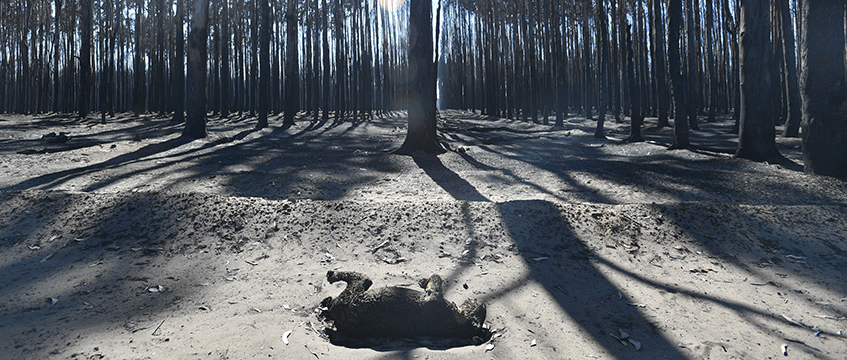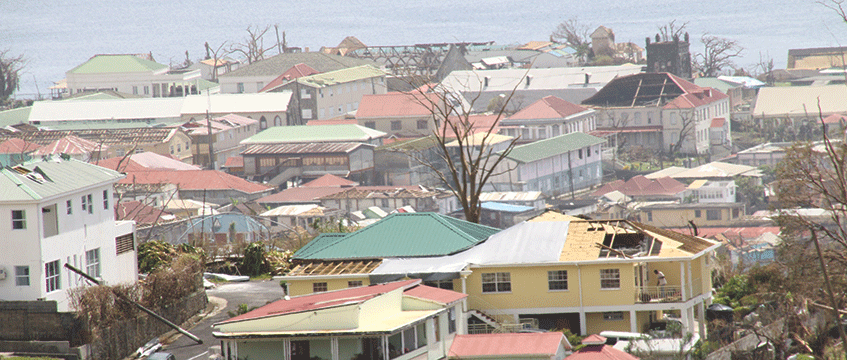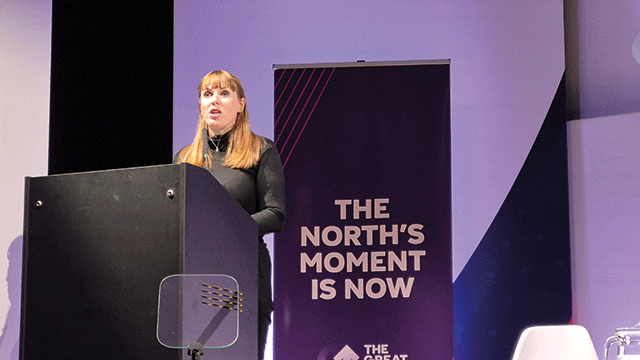It smelt like death on Kangaroo Island.
“You drive through burnt scrub and farmland and are confronted with the sight of dead, burnt animals everywhere you look,” said RSPCA South Australia chief inspector Andrea Lewis in January this year, detailing the aftermath of a bushfire that wiped out more than half of the island.
Photographs that Lewis published reveal the extent of the devastation; koalas on operating tables receiving emergency medical care, while those that survived in the wild cling to the charred remains of trees, scouring the decimated land for any signs of life.
This is just one example of the scale of damage that the bushfires have caused across Australia. Since June 2019, at least 33 people have died – including four firefighters – and more than 11m ha of land has been burnt. Although estimates vary, it has been reported that at least 1bn animals have died, 2,500 homes have been destroyed and the cost is expected to exceed the $4.4bn (£2.2bn) that was lost as a result of the 2009 fires.
The majority of the fires that struck the country at the end of 2019 and beginning of 2020 clustered down the east coast of Australia, although there have been fires in every state. However, New South Wales has been hardest hit.
Now it will be down to the real estate sector to, quite literally, pick up the pieces and rebuild the towns and cities.
But this is not just a story of rebuilding after tragedy. The fires are a stark, devastating warning about the state of the world and the response from the real estate sector must be two-fold. First, it must respond in the short to medium term by ensuring that future developments are built to withstand climate change-fuelled natural events. Second, and arguably even more critically, it must address its practices to embrace sustainability and reduce its contribution to the very crises giving it cause to rebuild in the first instance.
The fight of our generation
“Australia is on fire, people are dying and this is the fight of our generation. The property sector is about to face a pitchfork moment as people realise that climate change is, above all else, a real estate problem.”
So said Brendan Wallace when he revealed the details of his $200m Carbon Impact Fund to EG in January. The co-founder and managing partner of California-based VC fund Fifth Wall added that as the public, regulators and financial markets become increasingly focused on climate change, real estate – as the single biggest culprit – no longer has a choice when it comes to addressing its carbon footprint. Those who don’t change will not only be hit with huge financial penalties but will also have to face the wrath of the world.
“The industry needs to do something,” says Wallace. “People will be looking at you and asking, ‘what are you doing?’ We don’t believe the real estate sector has a good answer to that. But when people realise how culpable the industry is, they will be angry, and they will want action.”
That, he says, is why the Carbon Impact Fund has been launched. Led by venture partner Tyson Woeste, it will offer real estate companies the opportunity to invest in sustainable technology.
“There is often a focus on transportation and plastics when we talk about the climate crisis,” says Woeste. “But they are a drop in the bucket compared to real estate. While businesses might not understand that yet, regulators certainly do and huge financial burdens will mean massive consequences for the sector.”
So what is the sector going to do? Rebuilding after the bushfires is a good place to start – but only if it is done properly. Some experts claim the sector has one chance to prove it takes climate change seriously through its approach to rebuilding efforts thanks to eye-watering insurance premiums.
This is due to the inevitable spike in insurance that will come in the aftermath of the bushfires. In an update made on 14 January, the Insurance Council of Australia said that since November last year, insurers have received more than 13,750 catastrophe-related claims and estimated losses stand at $1.34bn. The ICA said it anticipates a further sharp increase in claims.
Jesse M Keenan, an architecture professor at Harvard University graduate school of design, says the real estate sector has “taken insurance for granted” over the years and the pay-outs the industry will get from bushfire damages should be viewed as the last of their kind.
“You get one ‘get out of jail free card’,” he says. “The insurance companies are going to pay out their insurance but the question is: what are you going to do with that money to build differently again and change what you’re doing so this won’t happen again on this scale? The next time won’t be so easy and will come at a much greater price.”
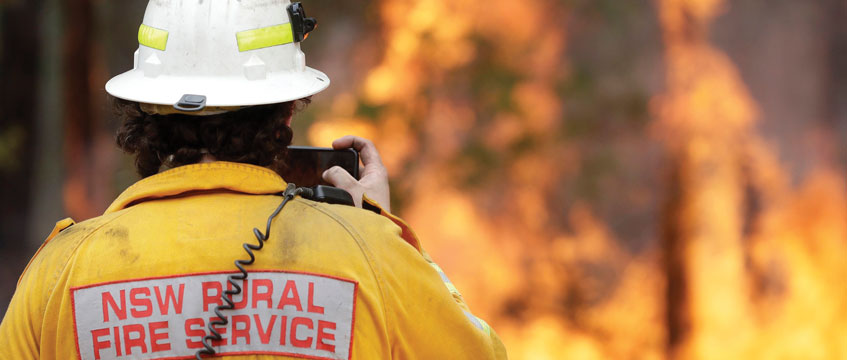
But what does this insurance pricing market correction actually look like? According to climate risk analyst Karl Mallon, whose company Climate Risk calculates the risks of climate change for private companies such as Deloitte, Zurich and Telstra, as well as for the public sector including the Australian government, this rise could be substantial. In the residential sector alone, Mallon says he is currently seeing insurance premiums rise to $30,000 a year in some cases.
Mallon estimates that over the past 30 years, an average of 100 properties per year have been destroyed by bushfires. But this year has seen unprecedented levels of damage, as the number of insurance claims submitted to the ICA indicates.
He estimates that, at present, one in 20 of Australia’s commercial and housing properties are at acute risk of being uninsurable, or that getting insurance for these buildings will be unaffordable. This will rise to one in 10 if no significant progress is made to adapt these buildings so that they can better withstand climate change risks.
“The big question is: are we in uncharted territory here?” asks Mallon. “What we’re seeing is a grey area emerge at the heart of the risk for the private sector – what happens when insurance starts to become expensive, unaffordable or unavailable?”
Rebuilding the country
As Keenan says, property companies need to radically rethink how to rebuild communities in a way that mitigates the risk of fire spread and damage. This is especially urgent if, like Mallon estimates, one in 10 properties could become uninsurable.
The country’s state governments need to work together to provide overarching and consistent guidance on what these fire risk mitigations could look like, Keenan says. This can be as simple as putting mesh up where there are gaps between houses to prevent birds nesting in these areas (which creates a fire hazard), to installing high-quality ventilation systems in buildings to ensure clean air is filtered in bushfire-prone areas, when air pollution can get particularly bad. But this collaboration needed between different states is a huge challenge.
Urban Land Institute for Sustainability and Economic Performance executive director Billy Grayson outlines further ways in which property companies can mitigate the risk of fire spread to the highest possible degree when building future developments – and agrees with Keenan that the public sector needs to play a role in supporting this change.
“They’re going to need better property management strategies to reduce bush, manage landscaping, and keep on-site water available,” he says. “Cities need to have better urban planning strategies so we’re not building in all the highest risk areas.”
Wider investment risks
The recent Australian bushfires are just one example of the ever-increasing symptoms of global climate change. These disasters are becoming ever more frequent, more extreme and more widespread, according to research conducted by insurance company Munich RE, which shows the number of extreme weather events increased by more than 250% between 1980 and 2013.
Grayson worked on a report released by the ULI alongside institutional investor Heitman on how investors are viewing and calculating the risks of climate change in prospective investments.
Work started on the Climate Risk and Real Estate Investment Decision-Making report in mid-2018 after a series of climate change-fuelled disasters – including hurricanes Harvey and Irene, typhoons, wildfires and mudslides – on the west cost of the United States started occurring more frequently.
“You had global real estate investors looking at the economic damage from extreme weather events and seeing its effects increasing,” Grayson says. “Investors were seeing the frequency, the magnitude and the extent of the economic damage to their portfolios… we had started to look at the long-term impacts of climate change, both on the likelihood and magnitude of these extreme weather events, but also on the long-term threat to real estate investment portfolios.”
Grayson says that investors have made “little progress” on assessing and pricing climate change risks, because the impacts are uncertain and the timeline relatively unknown. But investors are nevertheless making it a priority to understand climate change impacts on the sector because, as Grayson says, “the magnitude of the economic impact of this risk is tremendous. It could be catastrophic.”
If I was a publicly traded REIT, as those fires were burning, I would have been looking to see where I could build new apartment buildings
Markets located in areas prone to such events could be significantly affected he adds. “The investor operative options in dealing with this risk are to: hedge their portfolio, meaning invest in less risky cities and less risky assets, and they can also diversify away from those assets; exit markets completely because they have become too risky; or they can invest in mitigating the impact by hardening their asset or working with the city to make investments to protect them.
“At the heart of this, all of this costs money and hurts the profit of the real estate company.”
How will investors react to the recent fires over in Australia? Grayson says this event – as well as other climate change events such as a decade of droughts and two years of flooding in Queensland – will inevitably have a direct and indirect impact on property valuations in the country, which investors will take into account when choosing whether or not.
“Even if they [assets] don’t get impacted directly by fire and lose their value, they [assets] will be impacted in the future because of the availability and cost of insurance,” he says.
The impact on the sector will only continue to increase as extreme events such as these become more commonplace. But it is not all doom and gloom for the country – climate change is not the only risk factor that investors will take into consideration when making investment decisions, Grayson says.
“Australia has a lot of things going for it. It’s a beautiful country with a strong economy and global cities that are doing very well economically.”
Although the long-term impact that the Australian bushfires could have on the sector might be cause for concern, Keenan says they could present an opportunity for developers in the immediate aftermath.
“If I was a publicly traded REIT, as those fires were burning, I would have been looking to see where I could build new apartment buildings,” he says. This is because Keenan predicts people will start to migrate away from areas more prone to bushfires.
“For years and years now, there have been institutional investors that are looking at land banking in areas where they anticipate people will be migrating away from the coasts with climate change and sea levels rising. I would imagine that something similar would happen in Australia.”
Moving forward
As ULI and Heitman’s report outlines, climate change issues are becoming increasingly entwined in investment decision-making. A developer’s commitment to combatting these issues could even be the difference between some investors deciding to back a scheme or not.
Property may have one “get out of jail free” card to rebuild Australia but we also have one shot with our planet. It is up to the industry to act now or be held accountable forever.
Rebuilding after natural disasters – lessons learnt?
Dominica
In summer 2017, Hurricane Maria raged through Dominica, wiping out its whole agriculture industry, 95% of its infrastructure and causing damage equivalent to 226% of the country’s GDP. To rebuild the island would cost US$1.35bn.
Hurricane Maria, the fourth natural disaster to hit the country in 10 years, was the straw that broke the country’s back. Tired of the constant cycle of destruction the island was experiencing, prime minister Charles Savarin declared he wanted Dominica to be the first “climate-resilient nation in the world”.
Along with aid received from other countries, the Dominican government devised the Climate Resilience Execution Agency of Dominica, a framework for rebuilding the country to ensure it was more resilient to future disasters.
Over a period of 17 months, the government focused on rebuilding the island to ensure that buildings and infrastructure were designed to be as hurricane-proof as possible. This has included creating a geothermal energy power plant to increase the island’s use of renewable energy sources, as well as enforcing a plastic ban across the island.
As a result, the country has seen both social and economic benefits. More than 500 new homes have been built, and the United Nation’s Economic Commission for Latin America and the Caribbean report showed that Dominica saw the highest level of economic growth in 2019 (9%) compared to any other country in Latin America and the Caribbean.
Japan
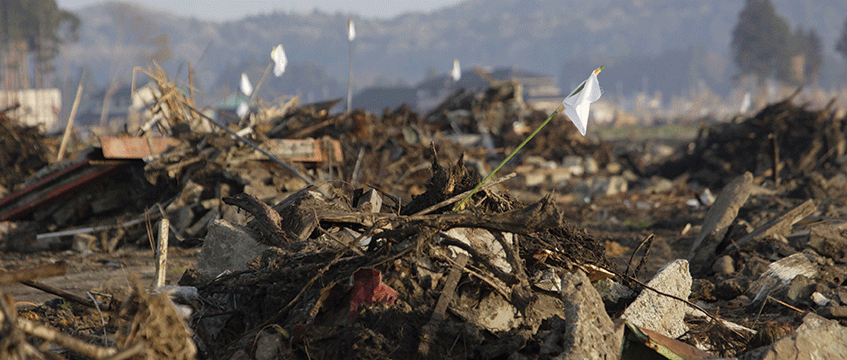
According to the US Geological Survey, Japan is one of the most earthquake-prone regions in the world.
The most powerful earthquake on record that struck the country was in 2011. The Great East Japan Earthquake triggered a tsunami that killed nearly 16,000 people, destroyed almost 130,000 homes and caused some $300bn damage. The snowball effect continued – reactors at Fukushima Daiichi Nuclear Power Plant were destroyed as a result and subsequently contaminated the surrounding area, forcing 100,000 residents to evacuate.
As a result, building codes have been made stricter and developers are now going to great lengths to ensure that new buildings are as earthquake-resilient as they can possibly be. Developer Mori has installed hydraulic oil dampers which act as shock absorbers against earthquakes on its Mori Tower building in Tokyo.
In the Ark Hills mixed-use tower, another of Mori’s developments, “sticky walls” have been installed. A sticky substance is injected into the inside of the steel plates of the building, which then act as a resisting force in the event of an earthquake.
Governors Island Park

Hurricane Sandy struck the US in autumn 2012, wreaking havoc across the Caribbean to the east coast of the US. More than 200 people were killed and the National Oceanic and Atmospheric Administration estimated that $70bn damage was caused.
But there was one part of New York – Governors Island – that remained undamaged.
The island’s landscape was designed in 2007 to be storm resilient. Previously the park was flat, but hills were created, lifting some parts of the park 16ft above sea level.
Trees were planted on the elevated parts of the island, meaning their roots would be out of reach of areas prone to any potential flooding. White walls were built in strategic places to protect the island against high waves in the event of a storm.
To send feedback, e-mail lucy.alderson@egi.co.uk or tweet @LucyAJourno or @estatesgazette







